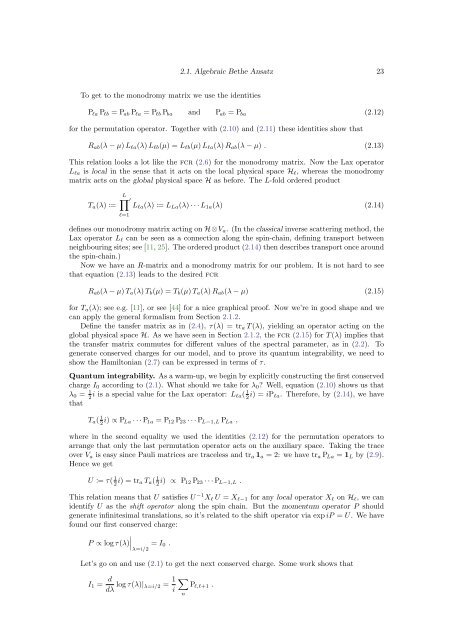The Bethe/Gauge Correspondence
The Bethe/Gauge Correspondence
The Bethe/Gauge Correspondence
Create successful ePaper yourself
Turn your PDF publications into a flip-book with our unique Google optimized e-Paper software.
2.1. Algebraic <strong>Bethe</strong> Ansatz 23To get to the monodromy matrix we use the identitiesP la P lb = P ab P la = P lb P ba and P ab = P ba (2.12)for the permutation operator. Together with (2.10) and (2.11) these identities show thatR ab (λ − µ) L la (λ) L lb (µ) = L lb (µ) L la (λ) R ab (λ − µ) . (2.13)This relation looks a lot like the fcr (2.6) for the monodromy matrix. Now the Lax operatorL la is local in the sense that it acts on the local physical space H l , whereas the monodromymatrix acts on the global physical space H as before. <strong>The</strong> L-fold ordered productT a (λ) :=L∏ ′l=1L la (λ) := L La (λ) · · · L 1a (λ) (2.14)defines our monodromy matrix acting on H⊗V a . (In the classical inverse scattering method, theLax operator L l can be seen as a connection along the spin-chain, defining transport betweenneighbouring sites; see [11, 25]. <strong>The</strong> ordered product (2.14) then describes transport once aroundthe spin-chain.)Now we have an R-matrix and a monodromy matrix for our problem. It is not hard to seethat equation (2.13) leads to the desired fcrR ab (λ − µ) T a (λ) T b (µ) = T b (µ) T a (λ) R ab (λ − µ) (2.15)for T a (λ); see e.g. [11], or see [44] for a nice graphical proof. Now we’re in good shape and wecan apply the general formalism from Section 2.1.2.Define the tansfer matrix as in (2.4), τ(λ) = tr a T (λ), yielding an operator acting on theglobal physical space H. As we have seen in Section 2.1.2, the fcr (2.15) for T (λ) implies thatthe transfer matrix commutes for different values of the spectral parameter, as in (2.2). Togenerate conserved charges for our model, and to prove its quantum integrability, we need toshow the Hamiltonian (2.7) can be expressed in terms of τ.Quantum integrability. As a warm-up, we begin by explicitly constructing the first conservedcharge I 0 according to (2.1). What should we take for λ 0 ? Well, equation (2.10) shows us thatλ 0 = 1 2 i is a special value for the Lax operator: L la( 1 2 i) = iP la. <strong>The</strong>refore, by (2.14), we havethatT a ( 1 2 i) ∝ P La · · · P 1a = P 12 P 23 · · · P L−1,L P La ,where in the second equality we used the identities (2.12) for the permutation operators toarrange that only the last permutation operator acts on the auxiliary space. Taking the traceover V a is easy since Pauli matrices are traceless and tr a 1 a = 2: we have tr a P La = 1 L by (2.9).Hence we getU := τ( 1 2 i) = tr a T a ( 1 2 i) ∝ P 12 P 23 · · · P L−1,L .This relation means that U satisfies U −1 X l U = X l−1 for any local operator X l on H l , we canidentify U as the shift operator along the spin chain. But the momentum operator P shouldgenerate infinitesimal translations, so it’s related to the shift operator via exp iP = U. We havefound our first conserved charge:P ∝ log τ(λ) ∣ = I 0 .λ=i/2Let’s go on and use (2.1) to get the next conserved charge. Some work shows thatI 1 = ddλ log τ(λ)| λ=i/2 = 1 i∑P l,l+1 .n
















